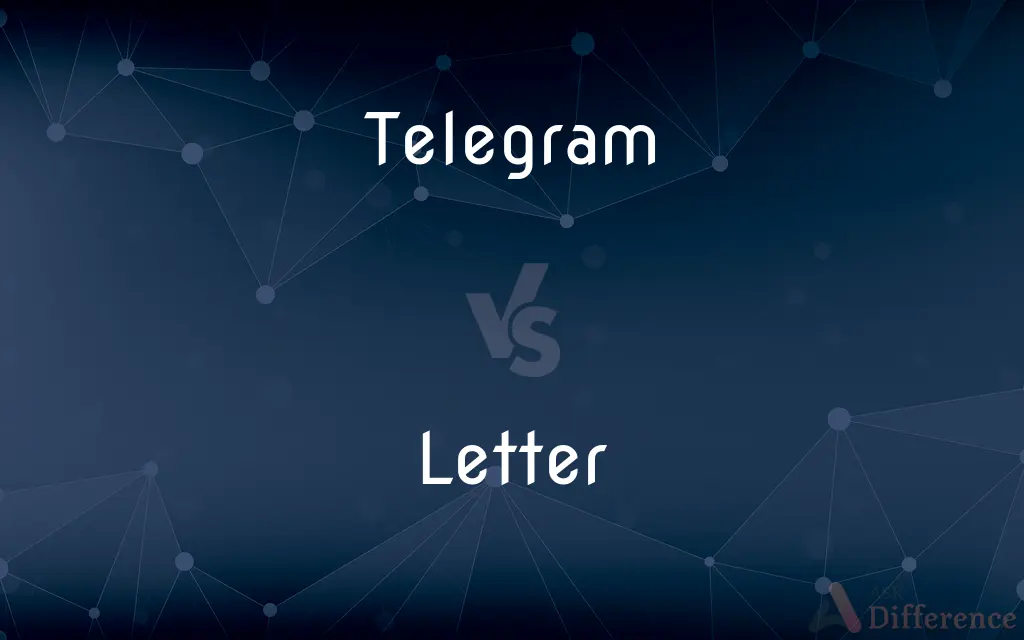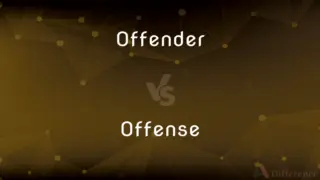Telegram vs. Letter — What's the Difference?
By Fiza Rafique & Maham Liaqat — Updated on March 29, 2024
A telegram is a concise message transmitted via telegraphy for rapid delivery, whereas a letter is a written message usually sent by postal mail, offering more space for detailed communication.

Difference Between Telegram and Letter
Table of Contents
ADVERTISEMENT
Key Differences
Telegrams historically were messages sent through a telegraph system, utilizing Morse code for speedy transmission over long distances. These messages were known for their brevity and often used for urgent or significant communications. In contrast, letters are written communications that can be lengthy or detailed, allowing the sender to express thoughts, feelings, or information without the constraints of brevity. Letters are typically sent through postal services and can take days to reach their destination, depending on the distance and mail service efficiency.
The telegram's cost was based on the number of words, encouraging senders to use as few words as possible to convey their message. This led to a unique style of writing that is direct and devoid of any unnecessary detail. On the other hand, the cost of sending a letter generally depends on its weight and size, not the length of the message, giving the writer the freedom to include as much content as they wish.
Telegrams were once the fastest method of long-distance communication, essential in times before the widespread use of telephones and the internet. They played a significant role in historical events, business, and personal communication. Conversely, letters have been a staple of human communication for centuries, valued for their personal touch and the physical connection they provide between sender and recipient.
The decline in the use of telegrams has been significant with the advent of faster, more efficient digital communication methods. Today, telegrams are largely obsolete, used more for novelty than necessity. Meanwhile, letters, despite the prevalence of email and instant messaging, still hold a place for formal communications, legal documents, and personal correspondence that benefits from a tangible medium.
While telegrams were primarily functional, lacking the space for embellishment or personal flair, letters can be personalized with handwriting, stationery, and enclosures, making them a popular choice for personal messages and occasions when a physical artifact of communication is desired.
ADVERTISEMENT
Comparison Chart
Medium
Telegraph system, Morse code.
Written or typed on paper.
Delivery Speed
Rapid, almost immediate.
Depends on postal system, usually days.
Cost Determination
Based on the number of words.
Based on weight and size.
Usage
Urgent or significant communications.
Detailed or personal communication.
Historical Significance
Essential for quick long-distance communication before digital era.
Centuries-old method of personal and formal communication.
Compare with Definitions
Telegram
A short message sent through a telegraph system.
He received a telegram announcing the birth of his niece.
Letter
A written message sent via postal mail.
She wrote a letter to her friend abroad.
Telegram
Cost based on word count.
They carefully worded the telegram to keep costs down.
Letter
Allows for detailed and personal communication.
The letter contained news of the past year.
Telegram
Known for its brevity and urgency.
The telegram read, Arriving 10 AM. Stop.
Letter
Can include enclosures like photos or documents.
The job application letter came with a resume.
Telegram
Now mostly obsolete or novelty.
They sent a novelty telegram as a wedding invitation.
Letter
Offers a tangible connection between sender and recipient.
He treasured the letters from his grandmother.
Telegram
Used for important news before the digital era.
The family sent a telegram to share their wedding date.
Letter
Still used for formal and legal documents.
They received a letter of acceptance from the university.
Telegram
A message transmitted by telegraph.
Letter
A character representing one or more of the sounds used in speech; any of the symbols of an alphabet
A capital letter
Telegram
To telegraph (something) or be telegraphed.
Letter
A written, typed, or printed communication, sent in an envelope by post or messenger
He sent a letter to Mrs Falconer
Telegram
A message transmitted by telegraph.
Letter
The precise terms of a statement or requirement; the strict verbal interpretation
We must keep the spirit of the law as well as the letter
The officer in the incident got in trouble for following the letter of the law
Telegram
(intransitive) To send a telegram.
Letter
Literature
The world of letters
Telegram
(transitive) To send a telegram to (a person).
Letter
A style of typeface.
Telegram
(transitive) To send (a message) in a telegram.
Letter
Inscribe letters or writing on
Her name was lettered in gold
Telegram
A message sent by telegraph; a telegraphic dispatch.
Letter
Be given a school or college initial as a mark of proficiency in sport
In high school she lettered in soccer, basketball and softball
Telegram
A message transmitted by telegraph
Letter
A written symbol or character representing a speech sound and being a component of an alphabet.
Letter
A written symbol or character used in the graphemic representation of a word, such as the h in Thames. See Note at Thames.
Letter
A written or printed communication directed to a person or organization.
Letter
Often letters A certified document granting rights to its bearer.
Letter
Literal meaning
Had to adhere to the letter of the law.
Letter
Literary culture; belles-lettres.
Letter
Learning or knowledge, especially of literature.
Letter
Literature or writing as a profession.
Letter
A piece of type that prints a single character.
Letter
A specific style of type.
Letter
The characters in one style of type.
Letter
An emblem in the shape of the initial of a school awarded for outstanding performance, especially in varsity athletics.
Letter
To write letters on
Lettered the paper.
Letter
To write in letters
Lettered our name on the mailbox.
Letter
To write or form letters.
Letter
To earn a school letter, as for outstanding athletic achievement
She lettered in three collegiate sports.
Letter
A symbol in an alphabet.
There are twenty-six letters in the English alphabet.
Letter
A written or printed communication, generally longer and more formal than a note.
I wrote a letter to my sister about my life.
Letter
The literal meaning of something, as distinguished from its intended and remoter meaning (the spirit).
Letter
Literature.
Benjamin Franklin was multiskilled – a scientist, politician and a man of letters.
Letter
(law) A division unit of a piece of law marked by a letter of the alphabet.
Letter (b) constitutes an exception to this provision.
Letter
A size of paper, 8½ in × 11 in (215.9 mm × 279.4 mm, US paper sizes rounded to the nearest 5 mm).
Letter
A size of paper, 215 mm × 280 mm.
Letter
Clipping of varsity letter
Letter
A single type; type, collectively; a style of type.
Letter
One who lets, or lets out.
The letter of a room
A blood-letter
Letter
(archaic) One who retards or hinders.
Letter
(transitive) To print, inscribe, or paint letters on something.
Letter
To earn a varsity letter (award).
Letter
One who lets or permits; one who lets anything for hire.
Letter
One who retards or hinders.
Letter
A mark or character used as the representative of a sound, or of an articulation of the human organs of speech; a first element of written language.
And a superscription also was written over him in letters of Greek, and Latin, and Hebrew.
Letter
A written or printed communication; a message expressed in intelligible characters on something adapted to conveyance, as paper, parchment, etc.; an epistle.
The style of letters ought to be free, easy, and natural.
Letter
A writing; an inscription.
None could expound what this letter meant.
Letter
Verbal expression; literal statement or meaning; exact signification or requirement.
We must observe the letter of the law, without doing violence to the reason of the law and the intention of the lawgiver.
I broke the letter of it to keep the sense.
Letter
A single type; type, collectively; a style of type.
Under these buildings . . . was the king's printing house, and that famous letter so much esteemed.
Letter
Learning; erudition; as, a man of letters.
Letter
A letter; an epistle.
Letter
A telegram longer than an ordinary message sent at rates lower than the standard message rate in consideration of its being sent and delivered subject to priority in service of regular messages. Such telegrams are called by the Western Union Company day letters, or night letters according to the time of sending, and by The Postal Telegraph Company day lettergrams, or night lettergrams.
A strange lock that opens with AMEN.
Letter
To impress with letters; to mark with letters or words; as, a book gilt and lettered.
Letter
A written message addressed to a person or organization;
Mailed an indignant letter to the editor
Letter
The conventional characters of the alphabet used to represent speech;
His grandmother taught him his letters
Letter
A strictly literal interpretation (as distinct from the intention);
He followed instructions to the letter
He obeyed the letter of the law
Letter
An award earned by participation in a school sport;
He won letters in three sports
Letter
Owner who lets another person use something (housing usually) for hire
Letter
Win an athletic letter
Letter
Set down or print with letters
Letter
Mark letters on or mark with letters
Common Curiosities
What is a telegram?
A telegram is a concise message transmitted via telegraphy, often used for urgent communication.
What makes a letter special in today’s digital age?
Letters maintain a personal touch and physical connection, making them special for personal and formal communications.
Why were telegrams important historically?
Telegrams provided a means for rapid long-distance communication, essential in times before digital communication.
Is the cost of sending a telegram more than a letter?
Historically, the cost of a telegram could be higher due to its word count pricing, especially for long messages.
Can a letter be as brief as a telegram?
While it can be, letters typically provide the opportunity for more extended communication.
How does a letter differ from a telegram?
A letter offers more space for detailed communication and is sent via postal mail, unlike the concise and rapid telegram.
Can telegrams still be sent today?
While largely obsolete, telegrams can still be sent for novelty or in very specific contexts.
Why might someone choose to write a letter today?
For personal touch, to include detailed information, or when a tangible form of communication is preferred.
What types of messages are typically sent in letters now?
Personal messages, formal invitations, legal documents, and any communication where email or digital methods are inappropriate.
What is the significance of handwriting in letters?
Handwriting adds a personal touch and uniqueness to letters, reflecting the sender’s personality.
How fast was telegram delivery compared to letters?
Telegrams were delivered much faster than letters, almost immediately after transmission.
What role did telegrams play in business?
Telegrams were used for urgent business communications, such as orders and critical updates.
Were telegrams used for personal or official communications more?
Telegrams were used for both, but were especially important for official and urgent messages.
Are there digital equivalents to telegrams today?
Yes, text messages, emails, and instant messaging serve similar purposes with greater efficiency and lower cost.
How were telegrams delivered to the recipient?
Initially by telegraph office personnel directly to the recipient’s address; later stages might involve phone calls or mail delivery.
Share Your Discovery

Previous Comparison
Offender vs. Offense
Next Comparison
Cut vs. RippedAuthor Spotlight
Written by
Fiza RafiqueFiza Rafique is a skilled content writer at AskDifference.com, where she meticulously refines and enhances written pieces. Drawing from her vast editorial expertise, Fiza ensures clarity, accuracy, and precision in every article. Passionate about language, she continually seeks to elevate the quality of content for readers worldwide.
Co-written by
Maham Liaqat













































